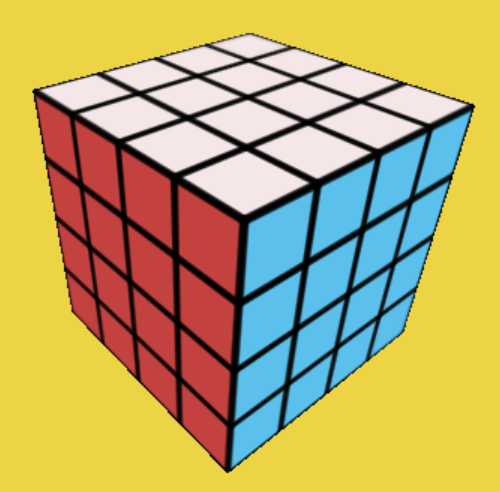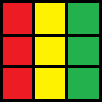Open-Source Project using TypeScript, Three.js and Scss.
I've got this idea by searching in my room for something I used to play with when I was young... and I found a easy Rubiks cube which was in 3x3
I wanted to make it possible to play with one virtually. So I came up with the idea of using Three.js for this project because I already had some experience with it in the past with my other Open-Source project cosmic-adventure.
npm install three
npm install sass
For the project to work: you will also need NodeJs installed.
The project turn using the vite vanilla-ts
The variable colors which is a array of 6 numbers in hexadecimal form for the faces of the cube
let colors: number[] = [0xFF521B, 0xC3423F, 0xF5E6E8, 0xFDE74C, 0x5BC0EB, 0x9BC53D];To show you how the cube is acting:
- the right is the orange
- the left is the red
- the top is the white
- the bottom is the yellow
- the front is the blue
- the back is the green
The array of the colors is [right, left, top, bottom, front, back]
The colors are set after with a simple variable named cubeMaterials which is a array of THREE.MeshBasicMaterial
let cubeMaterials: THREE.MeshBasicMaterial[] = [
new THREE.MeshBasicMaterial({color: colors[0], map: texture}),
new THREE.MeshBasicMaterial({color: colors[1], map: texture}),
new THREE.MeshBasicMaterial({color: colors[2], map: texture}),
new THREE.MeshBasicMaterial({color: colors[3], map: texture}),
new THREE.MeshBasicMaterial({color: colors[4], map: texture}),
new THREE.MeshBasicMaterial({color: colors[5], map: texture})
];The cube is made with help of 3 for loops i, j and k. To place the cubes I use the xPos, yPos and zPos:
let [xPos, yPos, zPos]: number[] = [cubeSize * (i - 1), cubeSize * (j - 1), cubeSize * (k - 1)];for the cubeGeometry, I used the variable cubeSize which is at 1:
let cubeGeometry: THREE.BoxGeometry = new THREE.BoxGeometry(cubeSize, cubeSize, cubeSize);So if you want to change the size of the cube or you want to make it bigger you can use these 2 variables:
let cubeSize: number = 1;
let cubeCount: number = 3;If you decrease the cubeCount to 2: it becomes a 2x2 rubiks cube.
If you increase the cubeCount to 4: it becomes a 4x4 rubiks cube.
For the the cubeSize variable it's to make simply the cube Bigger.
For the rotation I used 3 vectors:
- for the X axis
- for the Y axis
- for the Z axis
const [Vec1, Vec2, Vec3] = [new THREE.Vector3(turn, 0, 0), new THREE.Vector3(0, turn, 0), new THREE.Vector3(0, 0, turn)];The turn argument from the function CubeRotator() can only take numbers which are 1 or -1
- If it's a 1: the cube is rotation from top to bottom if clicked on the upper arrow
- If it's a -1: the cube is rotation from bottom to top if clicked on the upper arrow
To Move them they're put into variables: to show you how its mapped:
- The red side is called
leftCubesX - The yellow side is called
middleCubesX - The green side is called
rightCubesX
- The blue side is called
rightCubesY - The magenta side is called
middleCubesY - The dark red side is called
leftCubesY
The Z one are form the back the same combinations than red, yellow and green. He's never used.




